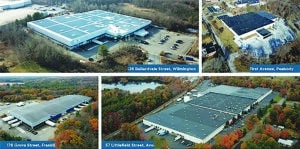
Pricing for suburban industrial assets now rivals that of office buildings in some suburban submarkets, but pales in comparison to the cost of acquiring industrial properties or land in Boston, Cambridge, or the inner suburbs. Photos courtesy of CBRE.
Boston remains the darling of both foreign and domestic real estate investors, a point underscored in the 2020 Emerging Trends in Real Estate report, co-published by the Urban Land Institute and PwC. Boston ranks No. 2 for investor demand, and while much of that capital is being directed to the red–hot office and lab markets, the industrial sector is drawing increasing interest, as limited supply has rents soaring to record levels.
On a national basis, industrial is outperforming all other real estate assets, and attracting an enormous amount of capital investment.
Last week Prologis announced it will acquire Liberty Property Trust and its 107 million square feet of industrial space for $12.6 billion, and in June Blackstone Group purchased a massive industrial portfolio for nearly $19 billion – with good reason. According to the trends report, industrial is expected to average 3 percent rent growth annually from 2019-2021, outpacing all property types; and industrial assets will average a total return of 8.7 percent through 2021, compared to 5.5 percent for apartments and office, and 2.8 percent for retail.
Locally, the numbers are equally impressive. According to the third quarter industrial report issued by Colliers International, the Boston industrial market has recorded over 900,000 square feet of positive absorption so far in 2019. Aggregate rents topped $10 for the first time ever in Q3, an increase of over 8 percent from Q3 2018.
Demand for industrial properties is also strong, as evidenced by a recent acquisition by Marcus Partners, which reportedly outbid over 100 investors spending $85 million for a four-property, 900,000 square foot suburban industrial portfolio. The same portfolio had been purchased separately between 2013 and 2015 for a total of $54.1 million. Earlier this year, Bentall Kennedy paid $51.7 million – nearly $300 per square foot – for a 173,000–square–foot FedEx warehouse built in 2013.
Pricing for suburban industrial assets now rivals that of office buildings in some suburban submarkets, but pales in comparison to the cost of acquiring industrial properties or land in Boston, Cambridge, or the inner suburbs. And while most of the recently acquired suburban properties will remain warehouse/distribution/manufacturing facilities, industrial assets in the urban core are increasingly being converted into the proverbial “higher and better uses”, i.e., multifamily and office/life science space.
Last year, DLJ Real Estate Capital Partners and Leggat McCall purchased a 3.4–acre office/industrial site in Boynton Yards in Somerville for $13.5 million, and are now constructing a 290,000–square–foot life science building on the site. In September, DLJ purchased another 3-acre adjacent site for $23 million. Similarly, Oxford Properties acquired a dilapidated building on a 1.29–acre industrial site in South Boston for $25 million, and it appears unlikely either site will be re-purposed for industrial uses, given the purchase prices and locations.
The dramatic rise in e-commerce, coupled with alternative uses for industrial properties – like breweries and small-scale manufacturing – and a growing Boston population will only further increase demand for industrial space. And Colliers reports that Lowe’s, Wayfair, Walmart and six other companies are currently seeking over 2.3 million square feet of industrial space, far more than what is currently under construction in the region. With increased the demand and an uncertain development pipeline, investor interest in the industrial sector should remain strong for the foreseeable future.
Michael Hoban is a writer for ULI Boston/New England.




 |
| 